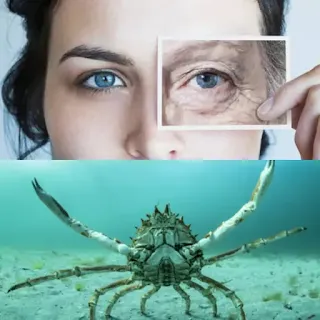Scientists have discovered a new 'drug-like' molecule that appears to slow aging by promoting the 'health' of cells.
A team from the Buck Institute in California has identified a compound in plants that boosts the cell's trash and recycling center, which declines as we age.
The team tested the biologically active compound with antioxidant and anti-inflammatory properties in small annelid worms, and found that their lives were extended by an average of 20 days, and some lived for more than 30 additional days.
The compound, found in cinnamon and many other plants, achieved its breakthrough in worms by working on a receptor of which humans also have a copy, suggesting that these results could extend to humans.
Scientists said that the new molecule is similar to a drug in maintaining the health of mitochondria (the energy generators found in most cells) through autophagy (or mitophagy), which basically means “eating mitochondria,” which is the process of removing and recycling damaged mitochondria in multicellular organisms.
The mitophagy-inducing compound (MIC) belongs to a class of molecules called coumarins, which are naturally found in cinnamon and tonka bean, among other plants.
“The mitophagy-inducing compound (MIC) is a great candidate moving forward given its therapeutic effect across multiple models and the fact that it is a natural molecule,” said study co-author Gordon Lithgow.
Dr. Manish Chamoli, lead author of the study, added that their work shows links to mitophagy, suggesting that drugs that enhance this process could offer a treatment that goes far beyond neurodegeneration or muscle wasting.
The study, published in the journal Nature Aging, found that lifespan was increased due to improved mitochondrial function in the worms through the powers of coumarin, a mitophagy-inducing compound (MIC).
As we age, the process of mitophagy slows, causing cellular waste to accumulate. This slowdown is linked to many age-related diseases, including Parkinson's disease, Alzheimer's disease, heart failure, obesity, and loss of muscle mass.
In the new study, scientists looked at a way to encourage autophagy in a small roundworm.
They began by examining a wide range of compounds found on neurons in laboratory dishes to see which would enhance the mitophagy.
“One of these compounds, mitophagy-inducing compound, has been very successful,” said Julie Andersen, one of the study’s senior authors, who researches neurodegenerative diseases at the Buck Institute for Research on Aging in Novato, California, in a statement.
Andersen explained that the mitophagy-stimulating compound enhances the transcription factor for the main protein EB, called TFEB for short, which cleans damaged cell components.
The compound works by inhibiting the nuclear receptor, which links gut health to brain function.
TFEB is a major contributor to the removal of unwanted cells, but faulty production can lead to age-related disorders.
When Andersen and her team gave the mitophagy-inducing compound to worms, it increased mitophagy, and in cultured mouse muscle cells, the same thing happened.
In worms, the mitophagy-inducing compound significantly increased lifespan compared to untreated worms.
MIC is a “promising drug-like molecule,” Andersen and her colleagues wrote in the study published Monday in the journal Nature Aging.
They found that it works against TFEB by blocking the action of a receptor protein called DAF. The human version of DAF, called FXR, regulates TFEB levels in the liver. But it is also found in brain cells, suggesting why the mitophagy-inducing compound acts on TFEB.
“This study provides another piece of the puzzle in terms of understanding the relationship between the brain and the gut in relation to health and disease,” Andersen noted.
It is noteworthy that the mitophagy-stimulating compound is not yet available as a nutritional supplement that can be taken to slow aging, so at the present time, healthy aging can be promoted in other ways such as sleep, diet, and exercise. Research also suggests that there are some ways to boost mitophagy, including intermittent fasting.
Crabs lead scientists to a wonderful underwater discovery!
Scientists have discovered an unprecedented hydrothermal vent teeming with life off the GalapZagos Islands by tracking the long path of a crab's movement.
While the team used an array of sensitive equipment to zero in on the potential site, seeing dense clusters of galathid crabs (genus Munidoposis) eventually led them to the new thermal field. It is located at the Galapagos Spread Center (GSC), a divergent boundary between the Cocos and Nazca tectonic plates about 400 kilometers north of the Galapagos Islands.
By tracking the ghostly white crustaceans, which congregate around deep-sea vents, they found a 9,178-square-metre field that the crew named “Sendero del Cangrejo,” or “Crab Trail.”
The research, organized by the Schmidt Ocean Institute, was carried out in the same area where the first hydrothermal field was confirmed in 1977 in the eastern region of the GSC.
There are approximately 550 known hydrothermal vents in the world, only half of which have been visually confirmed. The rest was inferred from chemical and temperature signatures in the water column.
Hydrothermal vents occur when water seeps into seafloor rocks either at the edge of a plate, such as that found in the GSC, or at a hotspot, where magma rises to the surface in another area of the plate.
In both cases, the water is heated by magma as minerals leached from the surrounding rock. The heat causes the water to rise, which is then released through cracks in the rock, often forming what are known as chimneys.
To locate the vent, the team first began searching the general area where a chemical anomaly was identified in 2008.
They then launched a remotely operated vehicle to inspect the seafloor and followed the crab's path to the vent field itself. There, they found a thriving ecosystem of uniquely adapted organisms, now known to be typical of hydrothermal vent environments.
The group intends to spend the next several years analyzing data and comparing notes in hopes of advancing our understanding of these remote environments.



